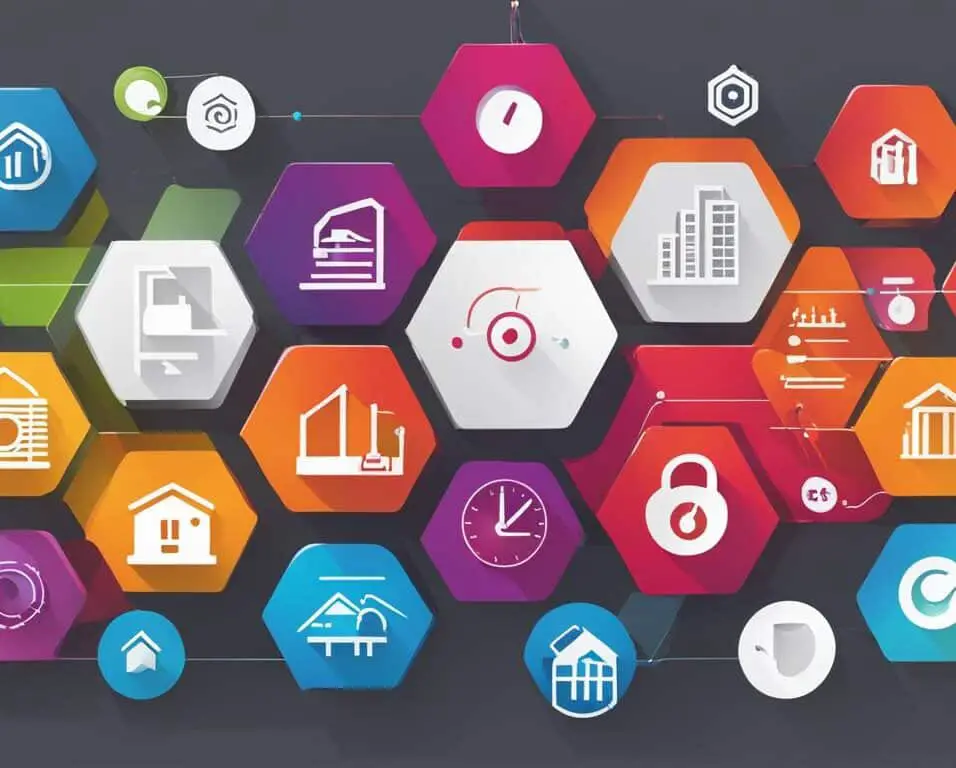Integrating IoT: A Guide to Smarter Living
The Internet of Things (IoT) has revolutionized how we interact with our environment, offering new opportunities for efficiency and connectivity. In the realm of smart homes, integrating IoT devices is the key to unlocking a future of seamless automation and enhanced convenience. By seamlessly integrating smart devices, homeowners can create efficient smart home solutions that cater to their specific needs and preferences.
Efficient smart home solutions are designed to simplify everyday tasks, optimize resource usage, and enhance the overall living experience. Through the integration of IoT devices, homeowners gain the ability to control various aspects of their environment effortlessly. From remotely controlling lighting and temperature to automating household appliances, the possibilities are endless.
However, integrating IoT devices in a smart home environment requires careful planning and consideration. Several factors need to be taken into account, including device compatibility, scalability, data management, and security. Let’s explore these essential considerations, strategies, and challenges involved in integrating IoT devices effectively.
Key Takeaways:
- Integrating IoT devices in smart homes enables efficient automation and enhanced convenience.
- Efficient smart home solutions optimize resource usage and simplify everyday tasks.
- Key considerations for integrating IoT devices include device compatibility, scalability, data management, and security.
- Successful strategies for IoT application integration involve API-based integration, middleware solutions, event-driven architecture, and iPaaS.
- Challenges in IoT integration include latency issues, data fragmentation, and interoperability.
The Landscape of IoT and Application Integration
The Internet of Things (IoT) has revolutionized the way we interact with technology, offering endless possibilities for a smarter and more connected world. In this section, we will explore the diverse landscape of IoT devices and the critical role of application integration in unlocking their full potential.
IoT devices come in various forms, from smart thermostats and wearables to connected appliances and security systems. These devices, manufactured by different companies, utilize various technologies and communication protocols. To harness their power, effective application integration is essential. It requires meticulous planning, technical understanding, scalability, and security.
Developers and businesses must focus on several key aspects to achieve seamless IoT integration:
- Compatibility: Due to the wide range of IoT devices available, ensuring compatibility among various devices, vendors, and protocols is crucial. An integrated ecosystem allows devices to communicate seamlessly and share data effectively.
- Scalability: As IoT ecosystems grow in terms of device numbers and data volumes, scalability becomes critical. The integration should be designed in a way that accommodates future expansion without compromising performance.
- Data Management: IoT generates massive amounts of data. Effectively managing and analyzing this data is essential for deriving insights and making informed decisions. Data collection, storage, cleansing, and analytics must be seamlessly integrated into the overall architecture.
- Security: With the increase in connected devices, security becomes paramount. IoT integration must incorporate robust security measures, including encryption, authentication, and access controls, to protect sensitive data and ensure the privacy and safety of users.
To illustrate the landscape of IoT and application integration, take a look at the following table:
| IoT Device | Manufacturer | Communication Protocol |
|---|---|---|
| Smart Thermostat | Nest | Wi-Fi, Zigbee |
| Smart Lock | August | Bluetooth, Wi-Fi, Z-Wave |
| Smart Speaker | Amazon | Wi-Fi, Bluetooth |
| Smart Lighting | Philips | Zigbee, Bluetooth |
Through effective application integration, these diverse IoT devices can work together harmoniously, creating a seamless and connected living experience.
Key Considerations for IoT Application Integration
When it comes to integrating IoT devices into a smart home ecosystem, several key considerations must be taken into account. These considerations include device compatibility, scalability, data management, and security. By addressing these factors, homeowners can ensure a seamless and secure integration that maximizes the potential of their smart homes.
Device Compatibility
In an IoT ecosystem that involves various device types, vendors, and communication protocols, device compatibility is of utmost importance. Ensuring that devices can effectively communicate with each other is essential for a cohesive and interconnected smart home experience. By choosing devices that are compatible with one another and implementing interoperable standards, homeowners can avoid potential integration issues and create a streamlined IoT environment.
Scalability
As IoT ecosystems grow in terms of the number of devices and the volume of data generated, scalability becomes a critical consideration. Homeowners need to ensure that their chosen integration solution can accommodate the increasing demand for device connectivity and data processing. Scalability allows for the seamless addition of new devices and the efficient handling of large amounts of data, ensuring that the smart home can continuously adapt and expand with evolving needs.
Data Management
The vast amounts of data generated by IoT environments present a unique challenge in terms of effective management. Homeowners need to establish robust data management practices to handle and transform this data into meaningful insights and actions. By implementing efficient data storage, processing, and analysis techniques, homeowners can derive valuable intelligence from their IoT devices, enabling informed decision-making and enhancing the overall smart home experience.
Security
Security is a significant concern in IoT ecosystems, as interconnected devices create potential vulnerabilities that can be exploited by malicious actors. Homeowners must adopt a zero-trust model and implement robust encryption algorithms to protect their IoT devices and the data they generate. By prioritizing security measures such as authentication, access controls, and data encryption, homeowners can ensure the confidentiality, integrity, and availability of their smart home systems.

“Device compatibility, scalability, data management, and security are crucial considerations when integrating IoT devices into a smart home ecosystem.”
Strategies for Successful IoT Application Integration
When it comes to integrating IoT devices into smart homes, several strategies have proven to be effective. These strategies provide the foundation for seamless integration, ensuring compatibility, scalability, and real-time responsiveness. In this section, I will explore four key strategies: API-Based Integration, Middleware Solutions, Event-Driven Architecture, and iPaaS.
API-Based Integration
API-Based Integration is a powerful approach that enables modular architectures and easy iteration. By utilizing RESTful APIs or real-time APIs, developers can establish secure and efficient communication channels between different IoT devices. This allows for seamless information exchange, ensuring that data can be collected, analyzed, and utilized effectively.
Middleware Solutions
Middleware solutions play a critical role in IoT application integration. They provide a layer of compatibility, allowing various devices with different protocols and communication methods to interact seamlessly. Additionally, middleware solutions offer data caching, transformation, and analytics capabilities, enabling efficient data management and processing.
Event-Driven Architecture
In an event-driven architecture, IoT devices generate asynchronous events in real-time, triggering actions and responses. This architecture ensures that devices can communicate and collaborate without unnecessary delays. By processing events as they occur, event-driven architecture enhances responsiveness and enables quick decision-making based on real-time data.
iPaaS (Integration Platform as a Service)
iPaaS refers to a cloud-based platform that provides comprehensive tools and services for designing, deploying, and managing integration flows. It offers a scalable and secure environment for connecting disparate systems and devices. With iPaaS, businesses can streamline their IoT application integration process, ensuring seamless data exchange and efficient workflow.
By implementing these strategies, businesses and homeowners can overcome the complexities of IoT application integration and harness the full potential of their smart home ecosystems. The combination of API-Based Integration, Middleware Solutions, Event-Driven Architecture, and iPaaS enables seamless connectivity, efficient data management, and real-time responsiveness.
| Strategy | Key Advantages |
|---|---|
| API-Based Integration | Modular architectures |
| Easy iteration | |
| Middleware Solutions | Compatibility |
| Data caching | |
| Data transformation | |
| Analytics capabilities | |
| Event-Driven Architecture | Real-time responsiveness |
| iPaaS | Cloud-based platform |
| Scalability | |
| Secure integration flows |
Challenges and Roadblocks
Integrating IoT devices in smart homes is not without its challenges. Overcoming these hurdles is crucial to ensuring seamless functionality and maximizing the benefits of a connected home environment. Let’s explore the key challenges faced in IoT application integration:
1. Latency Issues
Latency, or the delay in data transmission, can pose significant problems in real-time data processing for IoT systems. This delay can hinder the response time of connected devices, impacting the overall performance and user experience. Addressing latency requires optimizing network infrastructure, minimizing data processing time, and prioritizing critical data streams.
2. Data Fragmentation
IoT ecosystems consist of numerous devices that generate vast amounts of data from disparate sources. This data fragmentation can create obstacles when it comes to aggregating, analyzing, and deriving meaningful insights from the data. To overcome this challenge, organizations must implement effective data integration strategies, including data standardization and consolidation, to ensure a cohesive and unified data environment.
3. Interoperability
Interoperability issues can arise due to the presence of proprietary technologies and distinct communication protocols among different IoT devices. This lack of interoperability makes it difficult for devices to communicate and collaborate seamlessly, hindering the integration process. Overcoming interoperability challenges requires adopting open standards, leveraging common protocols, and implementing middleware solutions that bridge the communication gap.
Successfully addressing these challenges is crucial to achieve efficient, reliable, and scalable IoT application integration.
Key Steps to Overcome Challenges:
- Optimize network infrastructure to minimize latency.
- Standardize and consolidate data to overcome fragmentation.
- Implement open standards and middleware solutions for improved interoperability.

| Challenges | Impacts | Solutions |
|---|---|---|
| Latency Issues | – Delay in real-time data processing – Decreased device responsiveness |
– Optimize network infrastructure – Minimize data processing time – Prioritize critical data streams |
| Data Fragmentation | – Difficulty in aggregating and analyzing data – Inability to derive meaningful insights |
– Implement data standardization and consolidation – Establish a unified data environment |
| Interoperability | – Incompatibility between devices and protocols – Communication barriers |
– Adopt open standards – Leverage common protocols – Implement middleware solutions |
Conclusion
Integrating IoT devices into our homes is a game-changer, revolutionizing the way we live, work, and interact with our surroundings. Through careful consideration of key factors, effective implementation of strategies, and overcoming existing challenges, homeowners can unlock the full potential of IoT solutions for smarter living.
By embracing IoT, we can enhance convenience, efficiency, and sustainability. Imagine effortlessly controlling and managing all aspects of your home with a touch of a button or a simple voice command. From adjusting the thermostat and lighting to monitoring home security and optimizing energy usage, IoT solutions offer unparalleled control and automation.
Efficiency is at the core of smart home automation. With IoT, homeowners can save time, energy, and resources by streamlining various tasks and processes. Through intelligent integration of devices and systems, we can create a harmonious environment where everything works seamlessly together, optimizing our daily routines and enhancing productivity.
Smart home automation powered by IoT also brings an unparalleled level of security. With robust encryption algorithms and advanced monitoring capabilities, homeowners can have peace of mind knowing that their homes and personal data are well-protected. From remotely monitoring security cameras to receiving real-time alerts, IoT solutions provide us with a sense of control and safety.
FAQ
What is IoT?
IoT stands for the Internet of Things. It refers to the network of physical devices, vehicles, appliances, and other objects embedded with sensors, software, and connectivity to exchange data and enable the connection and communication between these objects and the internet.
How does application integration play a role in smart home solutions?
Application integration is crucial for seamless integration of IoT devices in smart homes. It enables different devices, manufacturers, and technologies to work together harmoniously, providing a more efficient and convenient experience for homeowners.
Why is device compatibility important in IoT ecosystems?
Device compatibility ensures that various types of devices from different vendors can communicate and work together effectively within an IoT ecosystem. It allows homeowners to integrate different devices seamlessly and create a truly interconnected smart home environment.
What is scalability in the context of IoT?
Scalability refers to the ability of an IoT ecosystem to handle the growth in terms of device numbers and data volumes. It ensures that the system can accommodate the increasing number of connected devices and the data they generate without any performance or stability issues.
What is the role of data management in IoT application integration?
Effective data management is essential in IoT environments as it involves handling and transforming massive amounts of data generated by connected devices. It includes data collection, storage, processing, and analysis to derive meaningful insights and enable smart home automation.
How does security play a role in IoT ecosystems?
Security is a significant concern in IoT ecosystems due to the potential vulnerabilities in interconnected devices. It requires a zero-trust model and robust encryption algorithms to protect sensitive data and prevent unauthorized access or malicious attacks.
What are some strategies for successful IoT application integration?
Some effective strategies for IoT application integration include API-based integration using RESTful or real-time APIs for modular architectures and easy iteration, middleware solutions for compatibility, data caching, transformation, and analytics, event-driven architecture for real-time processing of asynchronous events, and iPaaS for cloud-based platform management of integration flows.
What are the challenges faced in IoT application integration?
Some challenges in IoT application integration include high latency affecting real-time data processing, data fragmentation due to disparate data sources, and interoperability issues caused by proprietary technologies. Overcoming these challenges requires addressing latency, ensuring data consistency, and strategic planning for interoperability.
How can integrating IoT devices benefit smart home solutions?
Integrating IoT devices in smart home solutions enhances convenience, efficiency, and sustainability. It enables homeowners to automate various aspects of their homes, such as lighting, security, temperature control, and energy management, leading to increased energy efficiency, improved security, and personalized experiences.








